Back to Journals » Neuropsychiatric Disease and Treatment » Volume 19
Bibliometric Analysis of Research Themes and Trends of the Co-Occurrence of Autism and ADHD
Authors Liu A , Lu Y , Gong C, Sun J, Wang B, Jiang Z
Received 14 January 2023
Accepted for publication 5 April 2023
Published 24 April 2023 Volume 2023:19 Pages 985—1002
DOI https://doi.org/10.2147/NDT.S404801
Checked for plagiarism Yes
Review by Single anonymous peer review
Peer reviewer comments 2
Editor who approved publication: Dr Roger Pinder
Annan Liu,1,2 Yiwen Lu,3 Chao Gong,1,2 Jiaxing Sun,1,2 Bobo Wang,1,2 Zhimei Jiang4
1College of Rehabilitation Medicine, Jiamusi University, Jiamusi, Heilongjiang Province, People’s Republic of China; 2Neurolab for Child Rehabilitation, Jiamusi University, Jiamusi, Heilongjiang Province, People’s Republic of China; 3The First Affiliated Hospital, Guangxi Medicine University, Nanning, Guangxi Province, People’s Republic of China; 4Jiamusi University, Jiamusi, Heilongjiang Province, People’s Republic of China
Correspondence: Zhimei Jiang, Jiamusi University, Jiamusi, Heilongjiang Province, People’s Republic of China, Email [email protected]
Background: In recent years, there has been a growing body of research suggesting that ASD and ADHD are two disorders that often co-exist. Despite the rapid development of research, little is known about their etiology, diagnostic markers, and interventions, which has led us to review and summarise the development of the field in the hope that this will provide an opportunity to look for future directions.
Methods: A bibliometric approach was used to analyse papers in the field of ASD co-morbidities in ADHD on Web of Science from 1991– 2022, using CiteSpace and VOSview to map the country/institution, journal, author, co-citation, and keyword networks in the field and to visualise the results.
Results: A total of 3284 papers were included, showing an increasing trend in terms of posting trends. Research on co-morbidities of ASD has proven to be mainly focused on universities. The USA (1662) published the most relevant literature in this area, followed by the UK (651) and Sweden (388). Lichtenstein P is the most published author (84), and research into the pathogenesis of ASD co-occurring ADHD and related clinical diagnostics is currently at the forefront of the field.
Conclusion: This analysis identifies the most influential institutions and countries, cited journals, and authors in the field of ASD co-morbid ADHD research. The future direction of ASD co-occurring ADHD should be based on improving case identification, discovering the etiological and diagnostic markers of ASD and ADHD, and finding more effective clinical interventions.
Keywords: autism, hyperactivity, bibliometrics, VOSviewer, CiteSpace, visualization analysis
Introduction
Autism Spectrum Disorder (ASD) is a common neurodevelopmental disorder that begins in childhood, along with Attention Deficit Hyperactivity Disorder (ADHD).1,2 The core impairments of ASD are social interaction deficits and limited, narrow patterns of repetitive behaviour3 ADHD is characterised by symptoms of inattention, hyperactivity or impulsivity that are disproportionate to the level of development.4 ADHD is characterized by symptoms of inattention, hyperactivity, or impulsivity that are incompatible with development. Although the two disorders are defined by their distinct core syndromes, they have a high degree of clinical overlap.5 Currently, the Diagnostic and Statistical Manual of Mental Disorders 5th edition (DSM-5) diagnostic criteria consider a co-morbid diagnosis to be made if a person with ASD has significant ADHD symptoms.6 The DSM-5 criteria suggest that a co-morbid diagnosis can be made if a person with ASD has significant ADHD symptoms. Studies have found that the prevalence rate of ADHD among children with ASD is 37%~85%. Similarly, about 13% of children with ADHD had ASD.7 The prevalence of co-occurring ADHD in children with ASD has been increasing over time.
In recent years, there has been a growing body of research on the co-morbidity of ASD and ADHD. Researchers have found some overlap between ASD and ADHD in terms of disease characteristics. Firstly, in terms of clinical presentation, both children with ASD and children with ADHD may have symptoms such as attention deficit, hyperactivity and impulsivity, and difficulties with social interaction. The most common symptoms are attention deficit, hyperactivity, and impulsivity.8,9 The most common symptoms are attention deficit, hyperactivity, and impulsivity, but the core symptoms of ASD, such as social interaction difficulties, language difficulties, and stereotyped behavior, are also common in children with ADHD, especially in those with more severe ADHD.10 The core symptoms of ASD are particularly evident in more severe cases of ADHD. Secondly, the prevalence of ASD and ADHD in boys is higher than that in girls.11 In addition, both ASD and ADHD are associated with a higher prevalence of ASD than girls. In addition, both ASD and ADHD are strongly associated with genetic factors.12 In addition, both ASD and ADHD are associated with genetic factors. Therefore, it is necessary to summarise the history of the field of ASD co-morbidities in ADHD research, to identify current hotspots and potential trends, and to provide new ideas for future research.
CiteSpace is an excellent bibliometric tool that provides an overview of the structure of research in a field by mapping relevant knowledge, thus helping researchers to grasp the current state of research in the field from multiple perspectives.13 VOSviewer also has strengths in bibliometric analysis.14 This study is based on CiteSpace and VOSviewer for bibliometric and visual analysis. To the best of our knowledge, this is the first bibliometric analysis in the field of ADHD research on co-morbidities with ASD. We fill this gap and visualise trends in postings, collaborative networks (country, institution and author), published journals, keyword clustering, and keyword emergence in this research area. The aim is to provide a comprehensive analysis of research hotspots, future trends, challenges, and prospects for ADHD in ASD co-morbidity.
Methods
The bibliometrics research process is shown in Figure 1. A subject search was conducted in the Science Citation Index Expanded (SCI-E) database on WoS. The search was conducted in the Science Citation Index Expanded (SCI-E) database on WoS. The search was conducted from the date of creation to 31 October 2022. Type of literature: Article and Review. enter the following search terms in the subject field: (“autism” OR “autism spectrum disorder” OR “ASD” OR “autistic spectrum disorder”) AND (“attention deficit hyperactivity disorder” OR “attention deficit disorder with hyperactivity” OR “ADHD”) AND language = English. exclude newspapers, conferences, advertisements, and literature with incomplete and duplicate information. In the end, A total of 4110 papers were retrieved. After manual screening, 3284 articles were included, and data on the following variables were extracted: title, publication year, country, institution, journal, author, and keywords.
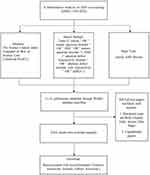 |
Figure 1 Flow chart of bibliometrics analysis. |
This study used CiteSpace (version 6.1.R3) and VOSviewer (version 1.6.10) for bibliometric analysis and data visualisation. Literature data were downloaded in plain text format, including title, author, abstract, source publication, cited literature and keywords. The normalised data were imported into VOSviewer 1.6.10 software to generate keyword network co-occurrence maps; the data were then imported into CiteSpace 6.0.R3 software for country/institution, author, keyword clustering, and emergent analysis, setting the time span to 1991–2022, with a time slice of 1 year, and setting the data with a Top N threshold, N=50, using pathfinder, pruning sliced networks and pruning the merged network clipping method for network clipping, clustering by LLR method, and drawing keyword clustering maps.
Results
Trends in Issuance
The search yielded a total of 3284 relevant articles. The number of articles published from 1991 to 2007 was low, with little change, and the research on ASD co-morbidities in ADHD was basically in its infancy during this period. In 2012, the number of articles exceeded 100 for the first time, after which the number of articles in this field increased exponentially and peaked in 2021. The number of articles published in 2022 is low as only the first 10 months of the literature are included in 2022. The overall trend shows that there has been significant research in the field in recent years and that there is great potential for future research (see Figure 2).
 |
Figure 2 The annual number of publications related to ASD co-occurring ADHD. |
Countries / Regions and Institutions
A total of 93 countries/regions have published research on ADHD-related studies on co-morbidities in ASD (see Figure 3). The circles in the figure represent the number of studies published and the lines represent collaboration with each other. Larger circles indicate more relevant studies published, and thicker lines indicate closer collaboration. Figure 4 shows the global distribution of publications in this area. The US has published the most relevant studies and started the earliest, but it is not the most central (centrality = 0.04). This may be because since the US is dominated by inter-institutional collaboration within the country. This is followed by the UK, Sweden, the Netherlands and China. A total of 320 institutions are involved in this area of research (see Figure 4). The top 10 institutions with the most published articles are listed in Table 1, with the Karolinska Institutet publishing the most articles, with 241 being published from 2008 to 2022, followed by King’s College London (217), the University of Gothenburg (133), the Radboud University Nijmegen (132 articles), and the University of Toronto (108 articles). Notably all 10 institutions are now globally renowned universities, reflecting the fact that ASD co-occurring ADHD research continues to be dominated by universities with leading international research platforms and high levels of excellence.
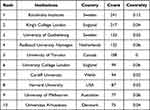 |
Table 1 Top 10 Institutions Published Analysis Concerning the Research of ASD Co-Occurring ADHD |
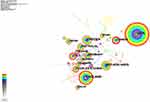 |
Figure 3 The network of countries/regions publications and collaborations. |
 |
Figure 4 World map based on the total publications of different countries/regions. |
Journals and Cited Journals
Of the 3284 articles published in 201 journals, 49 journals (24.38%) had ≥ 20 articles, and those with ≥ 100 articles included the Journal of autism and developmental disorders (240 articles), Journal of child psychology and psychiatry and allied disciplines (113 articles), Research in developmental disabilities (109 articles), and European child adolescent psychiatry (104 articles). The impact factors of these journals are generally high, and the accepted articles mainly study the current status and etiology of ADHD in ASD from the perspectives of brain structure, genes, psychology and epidemiology, and other hot issues (Table 2).
 |
Table 2 Top 10 Published Journal Analysis Concerning the Research of ASD Co-Occurring ADHD |
A total of 587 journals were cited for research related to ADHD in co-morbidities with ASD, and the 10 most frequently cited journals are shown in Table 3. Analysis by subject area was dominated by pediatrics, psychiatry and psychology. The Journal of autism and developmental disorders, the Journal of the American Academy of Child and Adolescent Psychiatry and the Journal of child psychology and psychiatry and allied disciplines were the most frequently cited journals, and the publishers of these journals were mainly based on the USA or the UK.
 |
Table 3 Top 10 Cited Journal Analysis Concerning the Research of ASD Co-Occurring ADHD |
Figure 5 shows the relationship between the citing and cited journals. We found that literature from the fields of psychiatry, psychology, and rehabilitation medicine had cross-citation relationships with literature from molecular biology, anatomy, genetics, etc. This indicates that the multidisciplinary culture of the field is effective, and researchers try to explain the pathogenesis of ADHD patients with ASD co-morbidities from the perspectives of molecular biology, genetics, and brain structure. And it is hoped that through rehabilitation and psychological intervention, patients can return to society sooner.
 |
Figure 5 A dual-map overlap of journals on ASD co-occurring ADHD carried out by Citespace. |
Author
A total of 457 authors published articles on ADHD-related research with ASD co-morbidities (see Figure 6). The nodes and lines in the graph represent individual authors and their collaboration with each other, the size of the nodes and the thickness of the lines represent the number of articles published and the tightness of the collaboration, and the warm and cold colors represent the distance in time. Table 4 shows the top 10 authors in terms of the number of publications, with Lichtenstein P having published 84 articles, followed by Gillberg C 78 articles and Buitelaar J 70 articles. According to Price Law the minimum number of articles by core authors (M) = 0.749 x √ nmax (nmax is the number of articles by the most productive authors)15 M = 0.749×9.2 ≈ 6.89, taking the integer 7, ie the number of core authors’ publications ≥ 7. 85 core authors were screened out, with a total of 1418 publications, accounting for 43.18% of the total publications (1418/3284), not reaching 50% of the total literature, indicating that a significant core author group has not yet been formed.
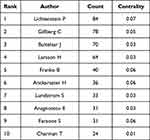 |
Table 4 Most Important Authors in the ASD Co-Occurring ADHD Research Field |
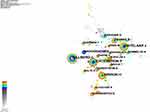 |
Figure 6 The network of authors’ publications and collaborations. |
Co-Cited Literature
Analyzing the co-cited literature can help us to understand the research themes and the context in which the field has developed, and these co-citations form the knowledge base for the research. A total of 846 references were co-cited and the 10 most cited articles are listed in Table 5. The most frequently cited articles were those published by Demontis D, Grove J, and Baio J respectively. These articles mainly included studies on the pathogenesis, diagnostic criteria, and epidemiology of this area of co-morbid ADHD in ASD.
 |
Table 5 Top 10 Co-Cited References Concerning the Research of ASD Co-Occurring ADHD |
Keywords
Keyword Mapping Co-Occurrence Analysis
Keywords are highly condensed versions of relevant features of scientific research, reflecting hot spots in the field and links between them.16 The keywords were extracted using VOSviewer and CiteSpace. VOSviewer and CiteSpace were used to extract keywords from the articles and construct a visual mapping based on the links between different keywords (Figures 7 and 8). Figure 7 uses VOSviewer 1.6.10 software to analyse the keywords in the literature related to ASD co-morbid ADHD, and analyses the co-occurrence network into 8 clusters, mainly related to clinical disease research, pathogenesis, treatment methods, and common co-morbidities of ASD co-morbid ADHD. Each circle in Figure 8 represents a keyword; the larger the circle, the higher the frequency of that keyword, and the line links two keywords together, with the whole graph reflecting the degree of association between keywords. The top 10 keywords in terms of frequency are autism spectrum disorder, children, attention-deficit/hyperactivity disorder, deficit hyperactivity disorder, ADHD, autism, prevalence, adolescent, spectrum disorder and psychiatric disorder. This suggests that disease type and diagnosis, population, and prevention measures are the hotspots of research on ASD co-morbidity with ADHD (Table 6).
 |
Table 6 The Co-Occurrence Keywords of ASD Co-Occurring ADHD Research |
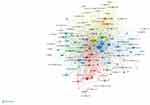 |
Figure 7 The network visualization map of keywords was performed with VOSviewer. |
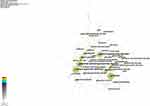 |
Figure 8 The network of keywords on ASD co-occurring ADHD. |
Keyword Clustering Analysis
Based on the keyword co-occurrence network, the LLR algorithm was used to cluster the keywords in the literature, showing the cluster labels with cluster IDs #0 to #17, and the visualisation results are shown in Figure 9. The cluster modularity value (Q) = 0.7716 > 0.3 and the mean profile value (S) = 0.9136 > 0.5, indicating that the clustering results were all significant and trustworthy. It was found that most of the clusters in the cluster mapping were more concentrated, suggesting that the clusters were closely linked and the research themes were close. A summary of the keywords with greater weight in the clustering is shown in Table 7. Centrality was as high as 0.52 for Autism and 0.48 for ADHD, which are comparable. Combined with the keyword clustering it is evident that perceptions about the disease have been the focus of research, with the etiology and clinical assessment of ASD and ADHD and the differential diagnosis of their co-morbidities being the focus of attention.
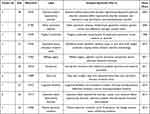 |
Table 7 Analysis of the Top 10 Clusters of Keywords in the ASD Co-Occurring ADHD Research Field |
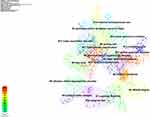 |
Figure 9 Visualization of the keywords cluster analysis. |
Keyword Timeline Analysis
The timeline view, with the year of occurrence of the keywords in the clusters on the X-axis and the clusters of each keyword on the Y-axis, further demonstrates the occurrence, end, and temporal trends of each cluster, and can reflect the importance of a particular cluster and the time span of its distribution. A timeline view analysis was conducted based on keyword co-occurrence (see Figure 10). Cluster themes #0 attention-deficit hyperactivity disorder, #1 other psychiatric diseases, and #2 fragile-x syndrome all emerged early, persisted to the present and, were hot. After 2010, “body mass index pregnancy”, ‘susceptibility Since 2010, keywords such as “body mass index pregnancy” and “susceptibility phenotype” have emerged, suggesting that the exploration and study of the etiology of ADHD in patients with ASD co-morbidities are becoming a focus of attention.
 |
Figure 10 The cluster timeline view network of keywords related to ASD co-occurring ADHD. |
Keyword Pop-Up
The keyword emergence analysis focuses on algorithmically deriving research hotspots that reflect the emergence or continued interest in the period time, reflecting changes and trends in hotspots in the research field. The keyword emergence analysis was obtained by adjusting the γ value based on keyword co-occurrence respectively, with the blue line indicating the time interval and the red line indicating the period time in which the keyword emergence was found (see Figure 11). “autism” and “Tourette syndrome” were the earliest (1991) words to emerge, and “Tourette syndrome “maintained a high intensity of emergence from 1991–2015, with an emergence intensity of 7.07, suggesting that ASD and ADHD share many similarities with Tourette’s syndrome and that they belong to the same mental disorder category and are closely related in terms of prevalence and treatment measures. Among all 25 emergent words, the keyword with the strongest emergent intensity was pervasive developmental disorder (41.29), and the highest intensity emergent word had an emergent intensity of over 40, indicating that the emergence of this keyword was significant, and all 25 keywords had an emergent intensity of over 6.5. gender difference” (8.05), “classification” (7.20), “asd” (8.82) and “gut microbiota” (6.88) were the most popular keywords in the field in the last five years. This indicates that the current exploration of co-occurring ADHD in ASD is increasingly focused on the underlying mechanisms of the disease, especially the important role of genetic factors in the etiology of co-occurring ADHD in ASD. The search for new and effective interventions is also an increasingly popular area of research in this field.
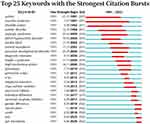 |
Figure 11 The top 25 keywords with the strongest citation bursts. |
Discussion
In this paper, we have used CiteSpace and VOSviewer software to systematically analyse the literature on ASD co-morbidities in the field of ADHD intuitively and effectively. Through the visualisation of the knowledge graph, we show the country/institution collaboration, authors, cited journals, and research hotspots in this field, revealing the research trends and cutting-edge trends in this field, which is a positive guide to promote the development of this field.
The trend in postings shows that research on ASD co-morbidities with ADHD began to take a large leap after 2012, and has since maintained a fluctuating upward trend with an overall increase. This rapid growth trend may be due to several factors. Firstly, the increasing social awareness of both ASD and ADHD has led to a growing number of scholars taking these two disorders seriously.17 Secondly, the Diagnostic and Statistical Manual of Mental Disorders 5th edition (DSM-5) has now been updated to include diagnostic criteria for ASD and ADHD, allowing for a diagnosis of co-morbidity between the two disorders.18 ASD and ADHD can be co-morbidly diagnosed. The new system is aimed toward a greater sensitivity for these individuals, providing earlier detection, diagnosis, and treatment planning. Overall, the goal behind the revisions of ASD and ADHD, is to create a category that represents the developmental trajectories of these disorders, which will create diagnostic systems that accurately accommodate the plasticity of neurodevelopment over the lifespan. As a result, more attention is being paid to the area of ASD co-morbidity with ADHD.
According to the analysis of country/geographical distribution, the research related to ASD co-morbidities shows a global participation pattern, with the top 10 countries in terms of the number of publications mainly located in Europe, North America, and Asia, especially the European-American countries have the highest participation and closer cooperation, such as France (centrality: 0.24), Russia (centrality: 0.21) and Canada (centrality: 0.19). This indicates that Euro-American countries are at the forefront of the world in the field of ASD co-morbidity ADHD. Apart from the Euro-American countries, China has the highest number of publications (320) but a low centrality (0.01), suggesting that although the number of publications in China has increased, there is still a lack of high-quality articles, probably due to China’s late start in this field, with the earliest available publication being in 2006.19 The earliest available paper was published in 2006, 15 years after the US, which has the highest number of publications. It is worth noting that, apart from China, the top ten countries with the highest number of publications are all developed countries, suggesting that research in this area in developing countries is significantly behind that in developed countries, which may be closely linked to poor government finances, low public health awareness and inadequate health care systems.20
The study of high-frequency publications and cited journals can help us understand the current state of ASD co-occurring ADHD research, thus enriching the theoretical basis of the field and improving the quality of relevant research articles. It can be seen that the impact factor of the publications and cited journals in the field of ASD co-occurring ADHD research is generally high, indicating that the quality of the articles published in this field is high and the papers published are of high academic value. The Journal of autism and developmental disorders is both the most published and most frequently cited journal, and is undoubtedly a core journal in this field, with recent articles reporting that the attention deficit symptoms of co-occurring ADHD in ASD may differ from the underlying neurological mechanisms of ADHD, and hoping that brain imaging and genetics studies, as well as ADHD-related symptomatology, will have an impact on the developmental changes in ASD symptoms. It is hoped that clinical interventions to manage developmental changes in ASD symptoms will further elucidate the behavioral symptoms of co-occurring ADHD in ASD and the mechanisms underlying them.21
The author’s collaboration network mapping allows us to understand the representative scholars in the field of ASD co-morbid ADHD research. The most published scholar is Lichtenstein P, whose main research interests are in the development of child health and behavioral problems.22–24 His most recent publication attempts to explain the inheritance and occurrence of mental disorders in children from a genetic and epidemiological perspective.25,26 The macroscopic view of the graph shows that the nodes are scattered, suggesting that only a few authors collaborate closely, eg Lichtenstein P and Anckarsater H are more connected to each other, suggesting closer collaboration. Other scientific collaborations between various scholars need to be strengthened to promote deeper development of the field.
Reading the high-frequency co-cited literature helps to provide a quick overview of important content in the field. The most frequently co-cited study is that of Demontis et al, which identifies variants surpassing genome-wide significance in 12 independent loci, finding important new information about the underlying biology of ADHD.27 Grove et al, found both quantitative and qualitative polygenic heterogeneity across ASD subtypes and this study was the second most frequently cited.28 Baio et al, reveal the latest prevalence of ASD, which is the third most frequently cited study.29
Keywords can directly reflect research hotspots. We summarized high-frequency keywords, conducted a cluster analysis of these keywords, constructed a keyword clustering timeline graph, and finally conducted an emergent analysis of keywords. We found that research on ASD co-morbidities with ADHD has focused on the etiology and clinical diagnosis of the two disorders. This is because exploring the etiology of ASD and ADHD can help to find the interrelationship between the two disorders and predict the risk of their occurrence, which can facilitate correct diagnosis and early intervention in children with the disorders, thus improving the outcome of the disorders. Research into the causes of co-occurring ADHD in ASD is still in the developmental stage. ASD and ADHD share similar neuropsychological mechanisms, and children with both disorders exhibit impaired executive function and response inhibition.30 ASD and ADHD share similar neuropsychological mechanisms. In terms of genetics, both ASD and ADHD are strongly associated with genetic factors.31 Both ASD and ADHD are genetically linked. The majority of current research suggests that the genetic basis for the co-morbidity of ASD and ADHD is the overlap of their causative genes. Researchers have conducted several studies on the genetic causes of ASD co-morbidity with ADHD, including family lineage analyses and twin studies, single gene studies, and multiple gene studies. Among them, in single causative gene studies, ADHD candidate genes such as DRD3 (dopamine D3 receptor gene) and MAOA (monoamine oxidase gene) may be associated with ASD symptoms.32 Some ASD candidate genes (eg 5-hydroxytryptamine-related genes) may also be associated with ADHD symptoms.33 However, these genetic studies still need more biological samples to obtain further and more comprehensive data. In terms of neuroimaging, structural MRI and functional MRI have revealed that while there are differences in brain structure and activity between children with ASD and those with ADHD, there are also similarities. For example, the corpus callosum, the white matter volume of the brain, was reduced in both ASD and ADHD patients.34 In terms of grey matter volume, the severity of symptoms in both children with ASD and children with ADHD has positively correlated with grey matter volume in the left inferior frontal gyrus.35 The severity of symptoms in both children with ASD and ADHD was positively correlated with the volume of the left inferior frontal gyrus. Functional MRI revealed low levels of activity in the frontal and parietal lobes in both ASD and ADHD patients.36
The correct diagnosis of co-occurring ADHD in ASD allows for a more specific determination of the child’s functional impairment.37 Children with co-occurring ASD have more severe impairments in cognitive functioning, social functioning, adaptive skills, and academic achievement.38 A correct and early clinical diagnosis is a prerequisite for the development of a comprehensive and effective treatment plan. The clinical diagnosis of ASD and ADHD currently relies on history, neuropsychological assessment and behavioral observations by the physician, and given the instability of this descriptive diagnosis, more and more research is focusing on identifying specific biomarkers of different psychiatric disorders, such as various neuroimaging, behavioral and cognitive measures.39 With the promulgation of the DSM-5, it is believed that future research on the diagnosis of co-occurring ADHD in ASD will progress more comprehensively.
Interventions for co-occurring ADHD in ASD seem to be gradually becoming a new research hotspot. In addition to traditional methods such as special education and psychotherapy, dietary supplements seem to be gaining popularity. For example, Omega-3 unsaturated fatty acids play an important role in the development of the central nervous system40 in children with ASD41 and children with ADHD.42 The use of Omega-3 unsaturated fatty acids in children with ASD and ADHD has shown promising results. In recent years, intervention studies targeting gut microbes have also emerged as a new therapeutic tool, with Shaaban et al’s open study of 30 children with ASD aged 5–9 years confirming that probiotic interventions not only resulted in beneficial changes in the gut flora of children with ASD but also in significant improvements in gastrointestinal and clinical symptoms.43 Partty et al found that continuous administration of Lactobacillus rhamnosus from birth to 6 months of age may reduce the risk of ADHD.44 The possible mechanism is that Lactobacillus rhamnosus may stabilise intestinal permeability by affecting the production of cellular tight junctions, mucins, and antigen-specific immunoglobulin A, reducing the risk of a range of neurobehavioural manifestations resulting from immune system activation following damage to the intestinal barrier.45 The risk of neurobehavioural manifestations due to immune system activation following intestinal barrier damage is reduced. However, it is important to note that interventions still require data from large clinical samples combined with rigorous methodological trials to provide more convincing evidence-based guidance.
Limitations
This study is subject to several limitations. Firstly, this study only included relevant literature from the WOS core collection for inclusion analysis, which may have introduced some bias to the analysis results. Secondly, although CiteSpace and VOSviewer are professional bibliometric tools that provide objective analysis, there may be some subjective bias as different researchers may have different views and interpretations of the same content. Finally, the quality of the literature varies and the global results on the overall structure of the research field may be more limited.
Conclusions
There is no doubt that our understanding of ASD co-morbidities in ADHD has advanced considerably through high-quality research over the past almost 30 years. With the help of visual analyses, we have identified general trends and research hotspots in the field. Based on these findings, we believe that research into the pathogenesis of ASD co-occurring ADHD and related clinical diagnostics is the main hotspot in this field and that interventions for ASD co-occurring ADHD will be the focus of future research.
Data Sharing Statement
The raw data supporting the conclusions of this article will be made available by Annan Liu, without undue reservation.
Author Contributions
All authors made a significant contribution to the work reported, whether that is in the conception, study design, execution, acquisition of data, analysis and interpretation, or in all these areas; took part in drafting, revising or critically reviewing the article; gave final approval of the version to be published; have agreed on the journal to which the article has been submitted; and agree to be accountable for all aspects of the work.
Funding
Jiamusi University Outstanding Subject Team Project (JDXKTD-2019006).
Disclosure
The authors declare that the research was conducted in the absence of any commercial or financial relationships that could be construed as a potential conflict of interest.
References
1. Johnson MH, Gliga T, Jones E, et al. Annual research review: infant development, autism, and ADHD – early pathways to emerging disorders. J Child Psychol Psychiatry. 2015;56(3):228–247. doi:10.1111/jcpp.12328
2. Dellapiazza F, Audras-Torrent L, Michelon C, et al. Clinical characteristics of children with ASD and comorbid ADHD: association with social impairment and externalizing and internalizing behaviours. Res Dev Disabil. 2021;113:103930. doi:10.1016/j.ridd.2021.103930
3. Lai M-C, Lombardo MV, Baron-Cohen S. Autism. Lancet. 2014;383(9920):896–910. doi:10.1016/S0140-6736(13)61539-1
4. Childress AC, Stark JG. Diagnosis and treatment of attention-deficit/hyperactivity disorder in preschool-aged children. J Child Adolesc Psychopharmacol. 2018;28(9):606–614. doi:10.1089/cap.2018.0057
5. Antshel KM, Russo N. Autism spectrum disorders and ADHD: overlapping phenomenology, diagnostic issues, and treatment considerations. Curr Psychiatry Rep. 2019;21(5):34. doi:10.1007/s11920-019-1020-5
6. Doernberg E, Hollander E. Neurodevelopmental Disorders (ASD and ADHD): DSM-5, ICD-10, and ICD-11. CNS Spectr. 2016;21(4):295–299. doi:10.1017/S1092852916000262
7. Davis NO, Kollins SH. Treatment for co-occurring attention deficit/hyperactivity disorder and autism spectrum disorder. Neurotherapeutics. 2012;9(3):518–530. doi:10.1007/s13311-012-0126-9
8. Mayes SD, Waxmonsky JG, Baweja R, et al. Symptom scores and medication treatment patterns in children with ADHD versus autism. Psychiatry Res. 2020;288:112937. doi:10.1016/j.psychres.2020.112937
9. Zablotsky B, Bramlett MD, Blumberg SJ. The co-occurrence of autism spectrum disorder in children with ADHD. J Atten Disord. 2020;24(1):94–103. doi:10.1177/1087054717713638
10. Panagiotidi M, Overton PG, Stafford T. Co-Occurrence of ASD and ADHD traits in an adult population. J Atten Disord. 2019;23(12):1407–1415. doi:10.1177/1087054717720720
11. May T, Adesina I, McGillivray J, et al. Sex differences in neurodevelopmental disorders. Curr Opin Neurol. 2019;32(4):622–626. doi:10.1097/WCO.0000000000000714
12. Polderman TJ, Hoekstra RA, Posthuma D, et al. The co-occurrence of autistic and ADHD dimensions in adults: an etiological study in 17,770 twins. Transl Psychiatry. 2014;4:e435. doi:10.1038/tp.2014.84
13. Chen C. Searching for intellectual turning points: progressive knowledge domain visualization. Proc Natl Acad Sci U S A. 2004;101(Suppl1):5303–5310. doi:10.1073/pnas.0307513100
14. van Eck NJ, Waltman L. Software survey: vOSviewer, a computer program for bibliometric mapping. Scientometrics. 2010;84(2):523–538. doi:10.1007/s11192-009-0146-3
15. Lopez-Munoz F, Tracy DK, Povedano-Montero FJ, et al. Trends in the scientific literature on atypical antipsychotic drugs in the United Kingdom: a bibliometric study. Ther Adv Psychopharmacol. 2019;9:2045125318820207. doi:10.1177/2045125318820207
16. Xu D, Wang YL, Wang KT, et al. A scientometrics analysis and visualization of depressive disorder. Curr Neuropharmacol. 2021;19(6):766–786. doi:10.2174/1570159X18666200905151333
17. Konst MJ, Matson JL, Goldin R, et al. How does ASD symptomology correlate with ADHD presentations? Res Dev Disabil. 2014;35(9):2252–2259. doi:10.1016/j.ridd.2014.05.017
18. Antshel KM, Zhang-James Y, Wagner KE, et al. An update on the comorbidity of ADHD and ASD: a focus on clinical management. Expert Rev Neurother. 2016;16(3):279–293. doi:10.1586/14737175.2016.1146591
19. Kao HSR. Shufa: Chinese calligraphic handwriting (CCH) for health and behavioural therapy. Int J Psychol. 2006;41(4):282–286. doi:10.1080/00207590544000059
20. Druetz T. Integrated primary health care in low- and middle-income countries: a double challenge. BMC Med Ethics. 2018;19(Suppl 1):48. doi:10.1186/s12910-018-0288-z
21. Carpenter KLH, Davis NO, Spanos M, et al. Adaptive behavior in young autistic children: associations with irritability and ADHD symptoms. J Autism Dev Disord. 2022. doi:10.1007/s10803-022-05753-2
22. Sandin S, Lichtenstein P, Kuja-Halkola R, et al. The familial risk of autism. JAMA. 2014;311:17. doi:10.1001/jama.2014.4144
23. Lichtenstein P, Olausson PO, Källén AJ. Twin births to mothers who are twins: a registry based study. BMJ. 1996;312(7035):879–881. doi:10.1136/bmj.312.7035.879
24. Lichtenstein P, De Faire U, Floderus B, et al. The Swedish Twin Registry: a unique resource for clinical, epidemiological and genetic studies. J Intern Med. 2002;252(3):184–205. doi:10.1046/j.1365-2796.2002.01032.x
25. Lee PH, Anttila V, Won H, et al. Genomic relationships, novel loci, and pleiotropic mechanisms across eight psychiatric disorders. Cell. 2019;179(7):1469–1482.e11. doi:10.1016/j.cell.2019.11.020
26. Jami ES, Hammerschlag AR, Ip HF, et al. Genome-wide association meta-analysis of childhood and adolescent internalizing symptoms. J Am Acad Child Adolesc Psychiatry. 2022;61(7):934–945. doi:10.1016/j.jaac.2021.11.035
27. Demontis D, Walters RK, Martin J, et al. Discovery of the first genome-wide significant risk loci for attention deficit/hyperactivity disorder. Nat Genet. 2018;51(1):63–75. doi:10.1038/s41588-018-0269-7
28. Grove J, Ripke S, Als TD, et al. Identification of common genetic risk variants for autism spectrum disorder. Nat Genet. 2019;51(3):431–444. doi:10.1038/s41588-019-0344-8
29. Maenner MJ, Shaw KA, Bakian AV, et al. Prevalence and characteristics of autism spectrum disorder among children aged 8 years - autism and developmental disabilities monitoring network, 11 sites, United States, 2018. MMWR Surveill Summ. 2021;70(11):1–16. doi:10.15585/mmwr.ss7011a1
30. Cooper M, Martin J, Langley K, et al. Autistic traits in children with ADHD index clinical and cognitive problems. Eur Child Adolesc Psychiatry. 2014;23(1):23–34. doi:10.1007/s00787-013-0398-6
31. Baranova A, Wang J, Cao H, et al. Shared genetics between autism spectrum disorder and attention-deficit/hyperactivity disorder and their association with extraversion. Psychiatry Res. 2022;314:114679. doi:10.1016/j.psychres.2022.114679
32. Staal WG, de Krom M, de Jonge MV. Brief report: the dopamine-3-receptor gene (DRD3) is associated with specific repetitive behavior in autism spectrum disorder (ASD). J Autism Dev Disord. 2012;42(5):885–888. doi:10.1007/s10803-011-1312-z
33. Seigneur E, Wang J, Dai J, et al. Cerebellin-2 regulates a serotonergic dorsal raphe circuit that controls compulsive behaviors. Mol Psychiatry. 2021;26(12):7509–7521. doi:10.1038/s41380-021-01187-x
34. Zhao Y, Yang L, Gong G, et al. Identify aberrant white matter microstructure in ASD, ADHD and other neurodevelopmental disorders: a meta-analysis of diffusion tensor imaging studies. Prog Neuropsychopharmacol Biol Psychiatry. 2022;113:110477. doi:10.1016/j.pnpbp.2021.110477
35. Lim L, Chantiluke K, Cubillo AI, et al. Disorder-specific grey matter deficits in attention deficit hyperactivity disorder relative to autism spectrum disorder. Psychol Med. 2015;45(5):965–976. doi:10.1017/S0033291714001974
36. Hoogman M, van Rooij D, Klein M, et al. Consortium neuroscience of attention deficit/hyperactivity disorder and autism spectrum disorder: the ENIGMA adventure. Hum Brain Mapp. 2022;43(1):37–55. doi:10.1002/hbm.25029
37. Hours C, Recasens C, Baleyte JM. ASD and ADHD comorbidity: what are we talking about? Front Psychiatry. 2022;13:837424. doi:10.3389/fpsyt.2022.837424
38. Harkins CM, Handen BL, Mazurek MO. The Impact of the Comorbidity of ASD and ADHD on Social Impairment. J Autism Dev Disord. 2022;52(6):2512–2522. doi:10.1007/s10803-021-05150-1
39. Uddin LQ, Dajani DR, Voorhies W, et al. Progress and roadblocks in the search for brain-based biomarkers of autism and attention-deficit/hyperactivity disorder. Transl Psychiatry. 2017;7(8):e1218. doi:10.1038/tp.2017.164
40. Healy-Stoffel M, Levant B. N-3 (Omega-3) fatty acids: effects on brain dopamine systems and potential role in the etiology and treatment of neuropsychiatric disorders. CNS Neurol Disord Drug Targets. 2018;17(3):216–232. doi:10.2174/1871527317666180412153612
41. James S, Montgomery P, Williams K, Omega-3 fatty acids supplementation for autism spectrum disorders (ASD). Cochrane Database Syst Rev. 2011;11:CD007992. doi:10.1002/14651858.CD007992.pub2
42. Bloch MH, Qawasmi A. Omega-3 fatty acid supplementation for the treatment of children with attention-deficit/hyperactivity disorder symptomatology: systematic review and meta-analysis. J Am Acad Child Adolesc Psychiatry. 2011;50(10):991–1000. doi:10.1016/j.jaac.2011.06.008
43. Shaaban SY, El Gendy YG, Mehanna NS, et al. The role of probiotics in children with autism spectrum disorder: a prospective, open-label study. Nutr Neurosci. 2018;21(9):676–681. doi:10.1080/1028415X.2017.1347746
44. Pärtty A, Kalliomäki M, Wacklin P, et al. A possible link between early probiotic intervention and the risk of neuropsychiatric disorders later in childhood: a randomized trial. Pediatr Res. 2015;77(6):823–828. doi:10.1038/pr.2015.51
45. Isolauri E, Kalliomäki M, Laitinen K, et al. Modulation of the maturing gut barrier and microbiota: a novel target in allergic disease. Curr Pharm Des. 2008;14(14):1368–1375. doi:10.2174/138161208784480207
 © 2023 The Author(s). This work is published and licensed by Dove Medical Press Limited. The
full terms of this license are available at https://www.dovepress.com/terms.php
and incorporate the Creative Commons Attribution
- Non Commercial (unported, v3.0) License.
By accessing the work you hereby accept the Terms. Non-commercial uses of the work are permitted
without any further permission from Dove Medical Press Limited, provided the work is properly
attributed. For permission for commercial use of this work, please see paragraphs 4.2 and 5 of our Terms.
© 2023 The Author(s). This work is published and licensed by Dove Medical Press Limited. The
full terms of this license are available at https://www.dovepress.com/terms.php
and incorporate the Creative Commons Attribution
- Non Commercial (unported, v3.0) License.
By accessing the work you hereby accept the Terms. Non-commercial uses of the work are permitted
without any further permission from Dove Medical Press Limited, provided the work is properly
attributed. For permission for commercial use of this work, please see paragraphs 4.2 and 5 of our Terms.
Recommended articles
Knowledge Mapping of Acupuncture for Fibromyalgia from 1990 to 2022: A Bibliometric Analysis
Li P, Zheng H, Chen Y, Liu Z, He J
Journal of Pain Research 2022, 15:2405-2426
Published Date: 18 August 2022
Knowledge Atlas of the Co-Occurrence of Epilepsy and Autism: A Bibliometric Analysis and Visualization Using VOSviewer and CiteSpace
Wang Y, Huo X, Li W, Xiao L, Li M, Wang C, Sun Y, Sun T
Neuropsychiatric Disease and Treatment 2022, 18:2107-2119
Published Date: 19 September 2022
Enhancing Literature Review and Understanding Under Global Pandemic
Qiao G, Song H, Hou S, Xu J
Risk Management and Healthcare Policy 2023, 16:143-158
Published Date: 3 February 2023
Bibliometrics Analysis and Visualization of Sarcopenia Associated with Osteoporosis from 2000 to 2022
Yang J, Jiang T, Xu G, Liu W
Journal of Pain Research 2023, 16:821-837
Published Date: 13 March 2023
Hotspots and Trends in Research on Treating Pain with Electroacupuncture: A Bibliometric and Visualization Analysis from 1994 to 2022
Hu L, Yang J, Liu T, Zhang J, Huang X, Yu H
Journal of Pain Research 2023, 16:3673-3691
Published Date: 3 November 2023
